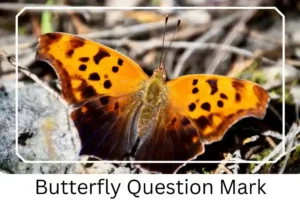Question Mark (Polygonia interrogationis)
The Question Mark butterfly, scientifically known as Polygonia interrogationis, is a captivating member of the anglewing butterfly family, boasting a broad distribution across the eastern United States, southeastern Canada, and extending to Mexico. This butterfly is renowned for its sizeable presence within its habitat, marking it as one of the largest butterflies in its geographic range. Its unique name, derived from a distinctive wing marking, invites curiosity and wonder about this beautiful creature.
Scientific Classification
- Family: Nymphalidae
- Genus: Polygonia
- Common names: Question Mark Butterfly
- Scientific Name: Polygonia interrogationis
Overview
Belonging to a group known for their angular wing shapes, the Question Mark butterfly exemplifies nature’s artistry through its lifecycle stages and seasonal color variations. Its habitat preferences, dietary habits, and migratory patterns reflect a complex interaction with the ecosystem, showcasing its adaptability and ecological importance. Observing this butterfly offers insights into the biodiversity of its range and the subtle beauty of nature’s designs.
Description and Identification
Caterpillar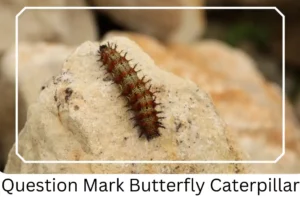
The Question Mark butterfly caterpillar is a sight to behold, measuring approximately 1.4 inches (3.6 cm) in length. It has a reddish-brown head adorned with short spines, each topped with branching spines. The caterpillar’s body is primarily black, accented with yellowish or white lines that may sometimes mask the black base. The spines vary in color from yellow to orange and black, adding to its distinct appearance.
Pupa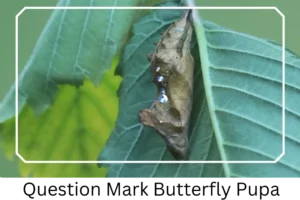
Transitioning into the pupal stage, the chrysalis exhibits a color palette ranging from dark brown to tan. Notably, it features four silvery-white spots arranged in two rows on the dorsal side of the thorax, complemented by a double row of spots with reddish tips near the abdomen, showcasing the intricate details of its metamorphosis.
Adult Butterfly
In its adult form, the Question Mark butterfly does not exhibit sexual dimorphism, meaning males and females share a similar appearance. The wing borders exude a powdery white hue, with the forewings displaying a vibrant orange color peppered with dark spots. The hind wings’ coloration varies seasonally, presenting as black in summer and orange in winter.
Sexual Dimorphism: Not present.
Color and Appearance: The adult butterfly’s wings exhibit distinct seasonal color variations and patterns, including the characteristic silver punctuation mark that inspires its name.
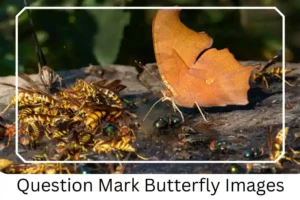
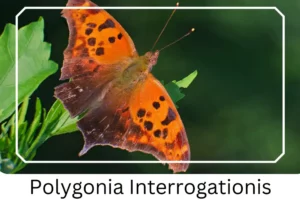 Average Wingspan: Ranges from 2 to 2.5 inches (5.2 to 6.4 cm), positioning it among the larger butterfly species in its habitat.
Average Wingspan: Ranges from 2 to 2.5 inches (5.2 to 6.4 cm), positioning it among the larger butterfly species in its habitat.
Flight Pattern: The Question Mark butterfly’s flight is notably erratic, with swift, gliding motions interspersed with rapid wing beats, adding to its mystique and allure.
Eggs
The eggs of the Question Mark butterfly are a striking green, laid individually or in stacks under the foliage of non-host plants. These butterfly eggs are distinguished by vertical ridges, a testament to the species’ intricate reproductive strategies.
Quick Facts | |
| Distribution | Eastern US, Southeastern Canada; migrates to Western Colorado, Cuba, and Newfoundland. |
| Habitat | Prefers open spaces with trees, wooded areas. |
| Lifespan of Adults | Typically ranges from 6 to 20 days. |
| Host Plants | Utilizes a variety of plants including American elm, Winged elm, Hackberry, Sugarberry, False nettle, and stinging nettle. |
| Adult Diet | Comprises tree sap, rotting fruit, carrion, dung, and flower nectar, showcasing the butterfly’s opportunistic feeding habits. |
How to Identify Question Mark Butterfly?
Identifying a Question Mark butterfly involves looking for its unique characteristics amidst its natural habitat. Start by observing the wings: in their folded state, they resemble dry leaves, camouflaging the butterfly against predators. The silver markings resembling a question mark on the underside of the wings are the most definitive trait. During different seasons, the upper side of the wings changes from black in the summer to orange in the winter, aiding in identification throughout the year. Additionally, the erratic flight pattern, a mix of gliding and swift wingbeats, distinguishes it from other species. By familiarizing oneself with these traits, enthusiasts and researchers alike can reliably spot and appreciate this remarkable species.
Did You Know?
- The Question Mark butterfly shares its genus, Polygonia, with the Comma butterfly, another species named after a punctuation mark, highlighting the thematic naming within their taxonomy.
- The mature pupa possesses the remarkable ability to mimic the colors of its surroundings, offering it exceptional camouflage against predators.
- This species plays a crucial role in pollination, contributing to the health and diversity of its ecosystem through its interactions with a variety of plant species.
Conclusion
The Question Mark butterfly is not just a marvel of nature’s design but also an essential participant in its ecosystem. Through its distinct life stages, unique identification markers, and ecological roles, it captivates the attention of both the scientific community and butterfly enthusiasts. Understanding and appreciating the complexity and beauty of species like the Question Mark butterfly is crucial for promoting biodiversity conservation and fostering a deeper connection with the natural world.
Question Mark Butterfly Pictures

Scientific Classification

- Family: Nymphalidae
- Genus: Polygonia
- Common names: Question Mark Butterfly
- Scientific Name: Polygonia interrogationis


